
Grafarkirkja Turf Church in North Iceland - the Oldest Turf Church in Iceland

Back in the olden days, Icelanders used to live in turf houses and the churches were made of turf. Now only a handful of turf churches remain in Iceland.
Top photo: beautiful Grafarkirkja church
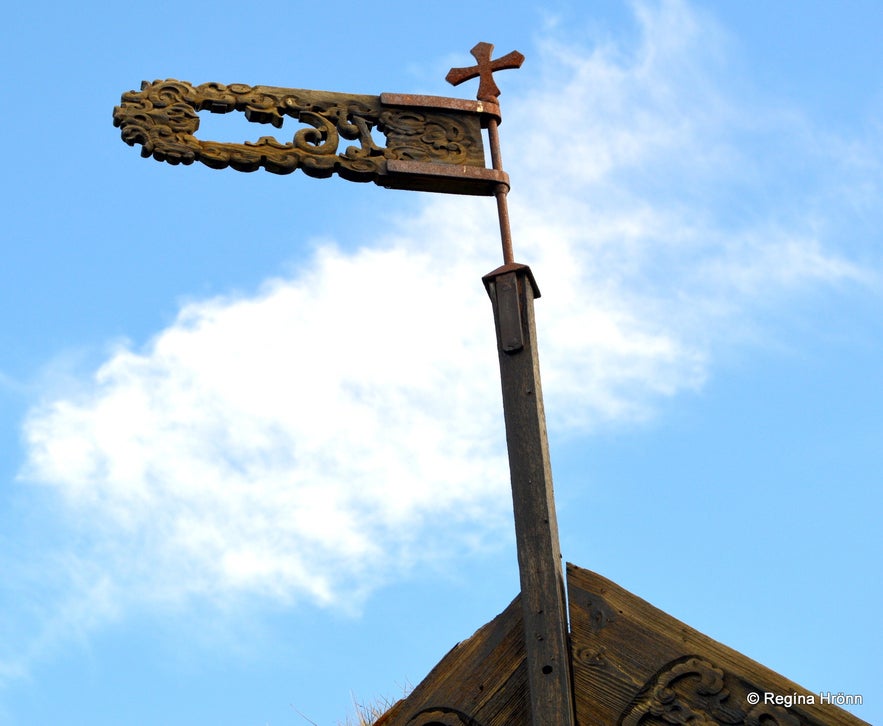
There is a weather vane on top of the church with the letters 167_ with the last symbol missing.
The oldest account on Gröf is from around 1240 and can be found in Sturlunga Saga, which is a collection of Icelandic Sagas from the 12th and 13th centuries.
Grafarkirkja church used to be open but is now closed to the public for its preservation. The turf churches are very delicate and need constant maintenance and too much traffic can destroy them, but you can walk up to Grafarkirkja church and have a look at it from the outside.
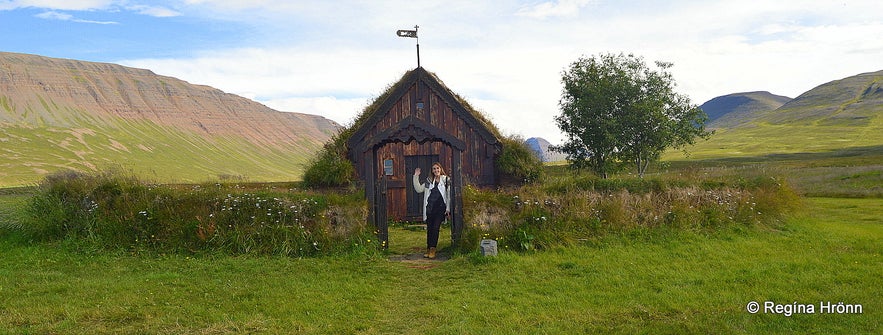
Grafarkirkja church
Grafarkirkja turf church is the only turf church in Iceland with a circular turf wall around the graveyard and the church, but such a circular form is an ancient form in Iceland.
A circular graveyard like this one, a little bit bigger though, can also be seen at Geirsstaðakirkja turf church in East Iceland, but that church is a hypothesis church built in the liking of an ancient turf church found in an archaeological dig.
Probably most churches in Iceland were similar to the Grafarkirkja turf church in olden times. It must have been such a lovely sight, seeing all these little turf churches all around Iceland!
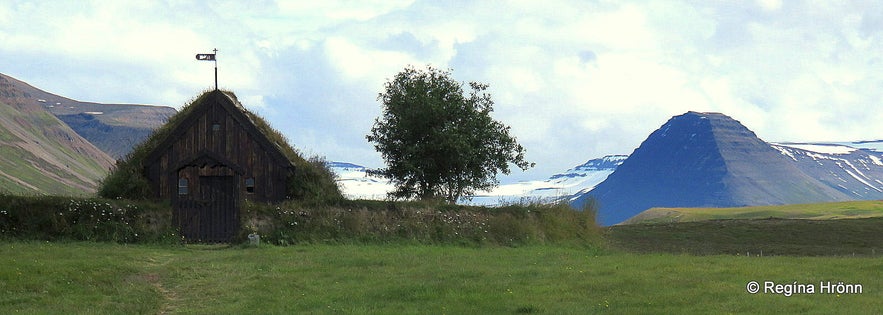
Grafarkirkja church
It is hard to believe when visiting this beautiful little church now that it was deconsecrated in 1765 by a royal order from the King, and used as a storeroom by the farmers at Gröf.
Grafarkirkja is a part of the National Museum of Iceland's Historic Building Collection and has belonged to the museum since 1939 when the Director of the National Museum of Iceland bought it for the museum.
Almost 2 centuries passed until the turf church was reconsecrated by the Bishop of Iceland in 1953 after being totally rebuilt in its original form by Þjóðminjasafn Íslands - the National Museum of Iceland. Again repairs were carried out in 2011.

Grafarkirkja church
Grafarkirkja church is 6.25 m long and 3.20 wide (ref. Hundrað ár á Þjóðminjasafni, Kristján Eldjárn). It is small but can seat around 30.
It is believed that the Bishops of Hólar Þorlákur Skúlason and his son Gísli Þorláksson (1631-1684) rebuilt Grafarkirkja church, but there is not enough evidence to confirm it. They owned the land Gröf in the late 17th century. A house of prayer had been at Gröf earlier on but it was in a state of neglect according to Kristján Eldjárn's abovementioned book.
Grafarkirkja was most likely built by Guðmundur Guðmundsson from Bjarnastaðahlíð, but he was one of the best-known wood-workers in Iceland in the 17th century. The wooden roof trims on the church itself have got beautiful baroque-style carvings.
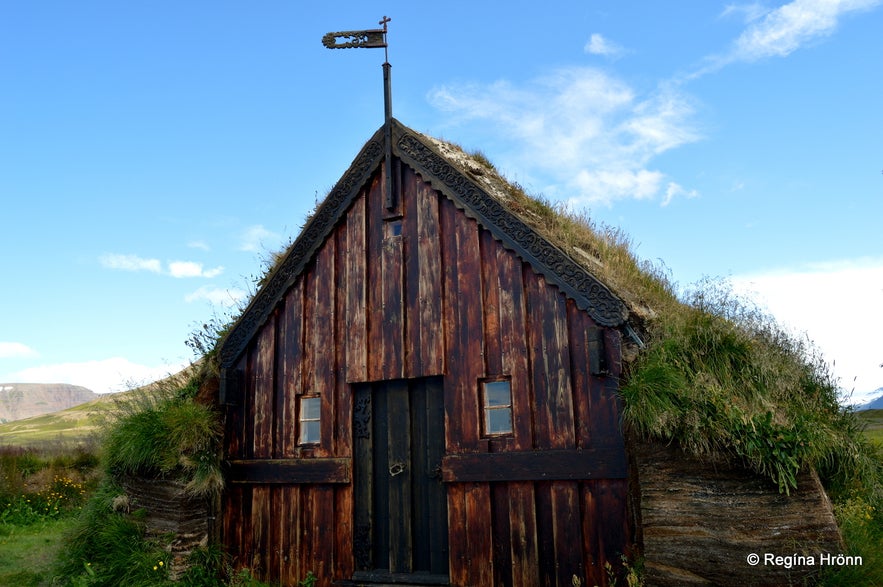
Grafarkirkja church
This turf church is the oldest looking of the 6 remaining turf churches in Iceland. It is, in fact, the only remaining so-called stave church in Iceland. It is made from timber and turf.
The altarpiece in Grafarkirkja is a reprint of the old baroque-style altarpiece from 1680. The Crucifixion and the Last Supper are depicted on the central panel and on the side panels the Apostles Andrew and Thomas are depicted.
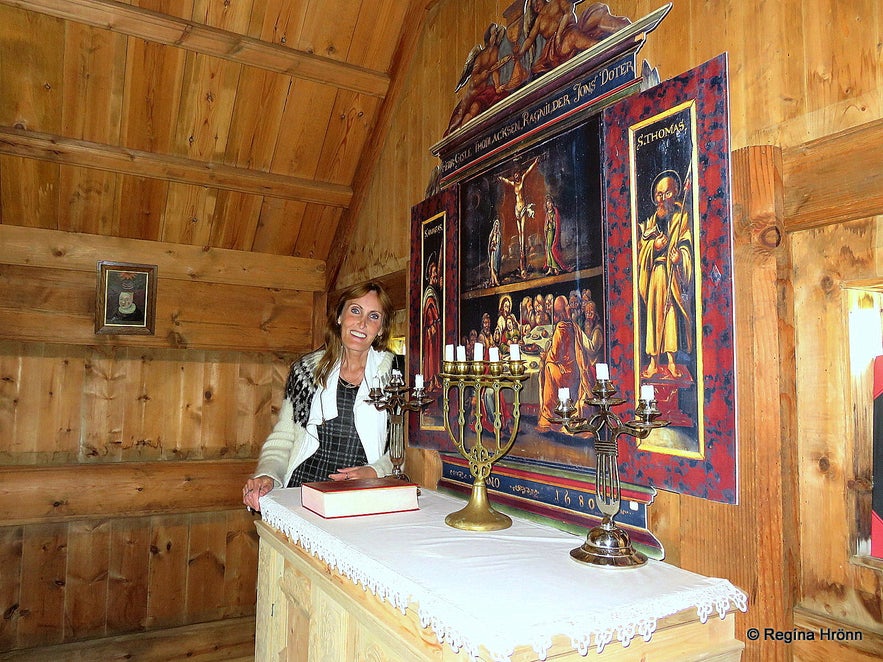
Inside Grafarkirkja church in 2015
The old baroque-style altar has been replaced. I remember seeing a different baroque-style altar with wood carvings on my previous visits.
And if I remember correctly then Helgi at Fornverkaskólinn told me some years ago that he was asked to remove either the altar or the altarpiece for preservation and put in replicas instead.
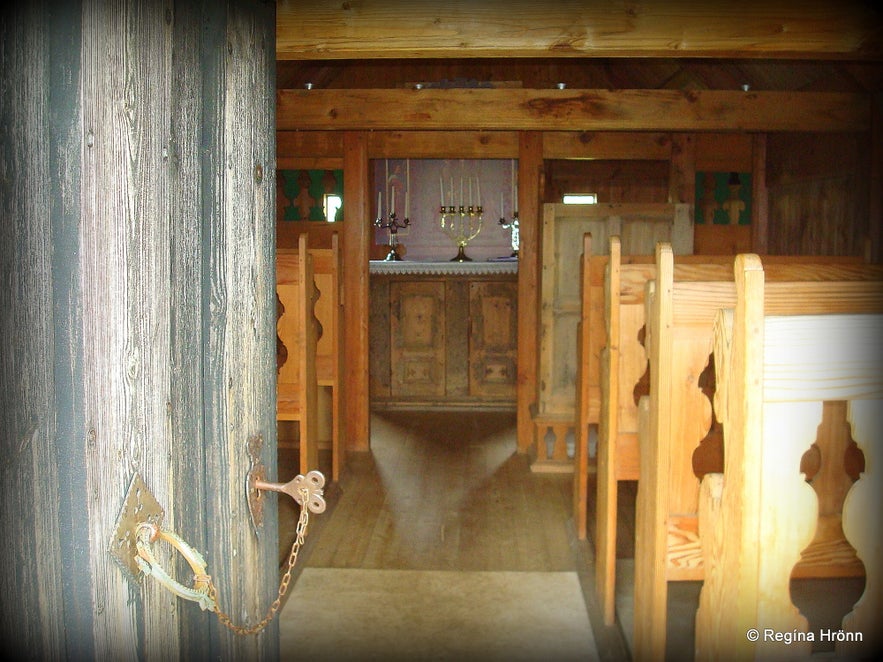 There was a different altar back in 2010 when I visited Grafarkirkja church
There was a different altar back in 2010 when I visited Grafarkirkja church
These little gems cannot withstand too much traffic so we must preserve them the best we can. My photos of the inside of the church are taken some years ago when it was still open.
Our beloved clergyman, poet, and hymnist Hallgrímur Pétursson (1614-1674) was most likely born at the farm Gröf, but he grew up at Hólar in Hjaltadalur. The biggest church in Iceland, Hallgrímskirkja church in Reykjavík is named after him.
Grafarkirkja belonged to Hólar in Hjaltadalur and after the Reformation, the land Gröf became the property of the bishops at Hólar and their families.
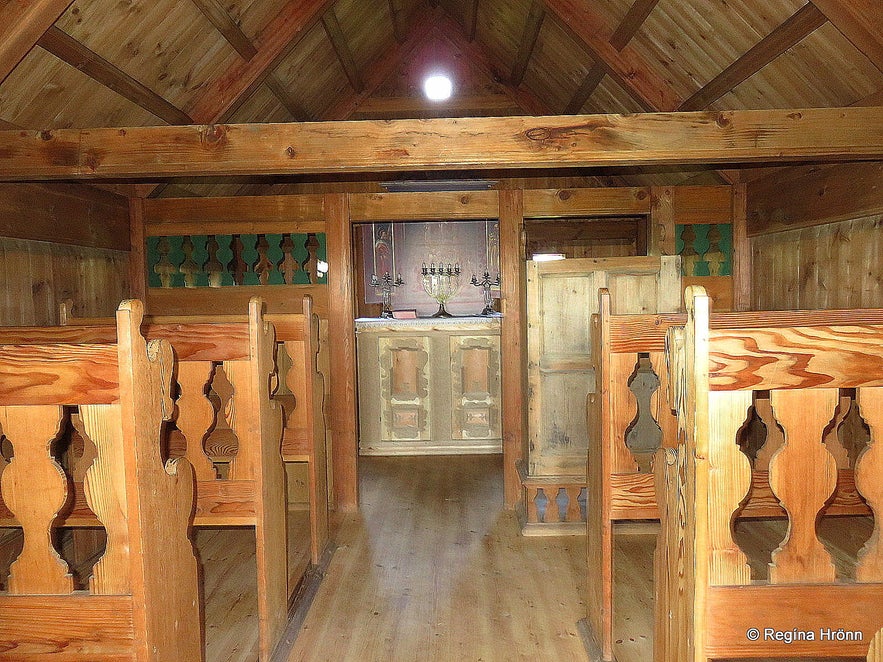
Inside Grafarkirkja church back in 2010
Ragnheiður Jónsdóttir (1646–1715) inherited Gröf from her husband Gísli Þorláksson, bishop at Hólar from 1657-1684.
Ragnheiður got permission from the King to have mass in Grafarkirkja every third holy day. In 1696 Ragnheiður Jónsdóttir married another bishop at Hólar, Einar Þorsteinsson.
Einar died shortly after and Ragnheiður, now twice a widow, moved back to Gröf and lived there until she died in 1715. Ragnheiður had no children of her own, but she had fostered two of her nieces, who inherited Gröf. After Ragnheiður's death, the heyday of Grafarkirkja regressed until the church was deconsecrated in 1765.
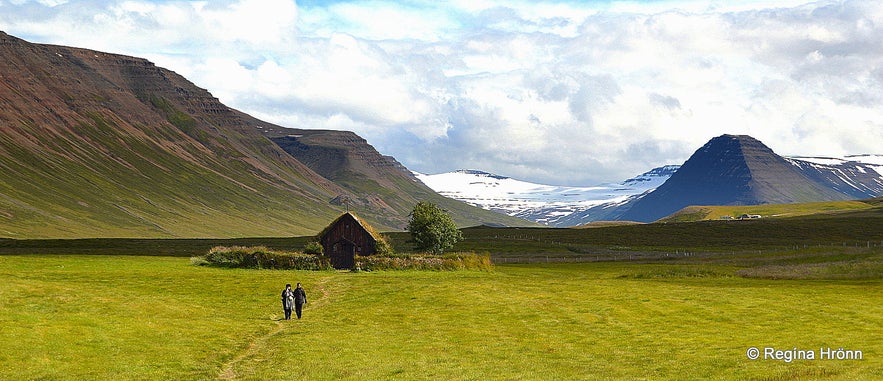
Grafarkirkja church
Grafarkirkja turf church looks like a jewel in the surrounding landscape. If you have a look at my photo above you will see a gallant mountain in the backdrop which complements the church - or the church complements the mountain - it is just perfect and one of my favourite photos :)
When I leave this beautiful turf church I cannot stop looking back at it - and I feel like I am looking back in time, it is so moving somehow. A path leads to the church and it takes only some 5 minutes to reach the church from the parking lot.
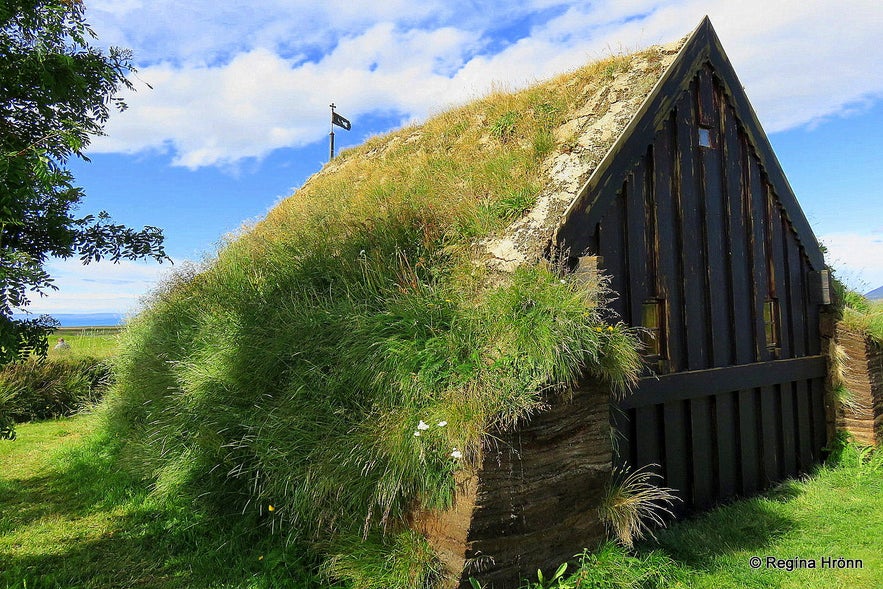
Grafarkirkja church
I have written travel-blogs about all the remaining turf churches in Iceland, f.ex. Víðimýrarkirkja and Saurbæjarkirkja turf churches in North Iceland and Hofskirkja turf church in southeast Iceland.
I adore these beautiful turf churches and am so glad that some of them have been preserved as historical monuments. Let's respect them as such and tread lightly when visiting them.
These turf churches and turf houses left in Iceland are so delicate that they cannot withstand too much traffic, as I told you earlier in this travel-blog.

The distance to Hólar from Grafarkirkja
Grafarkirkja church is by road 76 some 4 km south of the village of Hofsós in North Iceland. It is written on the rock by Grafarkirkja that Hólar in Hjaltadalur is 22 km away.
See also my travel-blog about the historical Hólar in Hjaltadalur valley.
If you want to have a look at more turf houses in Iceland then I have written a long travel-blog about the remaining turf houses:
A List of the beautiful Icelandic Turf Houses, which I have visited on my Travels in Iceland
Have a lovely time in North Iceland :)
기타 흥미로운 블로그
요쿨살론부터 비크까지, 꽃보다 청춘 5화
드디어 하늘씨과 쓰리스톤즈가 합류했는데요! 설원을 달리는 모습에 저도 아이슬란드가 엄청 그리워졌답니다. 빙하와 빛나는 요쿨살론 첫번째로 향한 요쿨살론(Jokulsarlon)은 아이슬란드의 대표적인 명소 중 하나랍니다. 영어로 Glacier lagoon 이라고도 하는데요. 방송에 나온 것처럼 눈 앞에 보이는 빙하는 빙하수가 흘러서 녹았다 얼었다를더 보기스코가포스 폭포부터 오로라까지, 꽃보다청춘 4화를 따라서
여행 5일째, 포스톤즈가 처음으로 향한 곳은 아이슬란드 남부에 있는 스코가포스 폭포(skogasfoss)입니다. 아이슬란드 남부의 대표적인 폭포 중 하나에요. 방송에서는 들르지 않았지만 스코가포스 거의 바로 옆에 위치한 셀리야란드스포스(seljalandsfoss) 폭포와 함께 같이 들르곤 한답니다. 스코가포스 폭포는 폭포의 물줄기 끝까지 올라갈 수 있단더 보기꽃청춘을 따라서
요즘 인기리에 방영되고 있는 꽃보다 청춘 아이슬란드편! 저도 매주 빼놓지 않고 시청하고 있습니다. 많은 분들께서 포스톤즈의 발랄한 매력과 아이슬란드의 놀라운 경치에 빠져드셨을 것 같습니다! 이번에는 꽃보다 청춘을 따라서 아이슬란드를 한번 가보도록 해요! 사실 아이슬란드가 한국에서 그렇게 가기 쉬운 나라는 아닙니다. 거리도 멀고 항공권도 비싸고! 우더 보기

아이슬란드 최대의 여행 마켓플레이스를 전화에 다운로드하여 전체 여행을 한 곳에서 관리하세요
전화 카메라로 이 QR 코드를 스캔하고 표시되는 링크를 누르면 아이슬란드 최대의 여행 마켓플레이스를 주머니에 넣을 수 있답니다. 다운로드 링크가 포함된 SMS 또는 이메일을 받으려면 전화번호 또는 이메일 주소를 추가하세요.
















